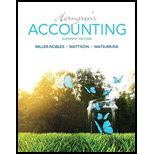
Concept explainers
Concept Introduction:
Allowance method: Under the Allowance method the estimated
Direct write off method: Under the Direct write off method the actual bad debts are directly written of using the
Requirement-1:
To prepare: The
Requirement-2:
To prepare: The Journal entries and T accounts to record the given transactions using the Direct Write off method
Requirement-3:
The amount of bad debts expense to be reported in September Income Statement under both the methods and better method to match the revenue with expenses
Requirement-4:
The amount of Net Accounts Receivable to be reported on September 30, 2016
Want to see the full answer?
Check out a sample textbook solution
Chapter 9 Solutions
Horngren's Accounting (11th Edition)
- I am trying to find the accurate solution to this general accounting problem with appropriate explanations.arrow_forwardI need help with this general accounting question using standard accounting techniques.arrow_forwardI am looking for a reliable way to solve this financial accounting problem using accurate principles.arrow_forward
- I need help with this general accounting problem using proper accounting guidelines.arrow_forwardPlease explain the solution to this general accounting problem using the correct accounting principles.arrow_forwardCan you help me solve this general accounting question using the correct accounting procedures?arrow_forward
- Horngren's Financial & Managerial Accounting: The Managerial Chapters, 8th Edition. E-M:9-14 Describing the balanced scorecard and identifying key performance indicators for each perspectiveConsider the following key performance indicators and classify each indicator according to the balanced scorecard perspective it addresses. Choose from the financial perspective, customer perspective, internal business perspective, and the learning and growth perspective. a.Number of customer complaintsb.Number of information system upgrades completedc.Residual incomed.New product development timee.Employee turnover ratef.Percentage of products with online help manualsg.Customer retentionh.Percentage of compensation based on performancei.Percentage of orders filled each weekj.Gross margin growthk.Number of new patentsl.Employee satisfaction ratingsm.Manufacturing cycle time (average length of production process)n.Earnings growtho.Average machine setup timep.Number of new customersq.Employee…arrow_forwardDo fast answer of this general accounting questionarrow_forwardPlease provide the solution to this general accounting question with accurate accounting calculations.arrow_forward

 AccountingAccountingISBN:9781337272094Author:WARREN, Carl S., Reeve, James M., Duchac, Jonathan E.Publisher:Cengage Learning,
AccountingAccountingISBN:9781337272094Author:WARREN, Carl S., Reeve, James M., Duchac, Jonathan E.Publisher:Cengage Learning, Accounting Information SystemsAccountingISBN:9781337619202Author:Hall, James A.Publisher:Cengage Learning,
Accounting Information SystemsAccountingISBN:9781337619202Author:Hall, James A.Publisher:Cengage Learning, Horngren's Cost Accounting: A Managerial Emphasis...AccountingISBN:9780134475585Author:Srikant M. Datar, Madhav V. RajanPublisher:PEARSON
Horngren's Cost Accounting: A Managerial Emphasis...AccountingISBN:9780134475585Author:Srikant M. Datar, Madhav V. RajanPublisher:PEARSON Intermediate AccountingAccountingISBN:9781259722660Author:J. David Spiceland, Mark W. Nelson, Wayne M ThomasPublisher:McGraw-Hill Education
Intermediate AccountingAccountingISBN:9781259722660Author:J. David Spiceland, Mark W. Nelson, Wayne M ThomasPublisher:McGraw-Hill Education Financial and Managerial AccountingAccountingISBN:9781259726705Author:John J Wild, Ken W. Shaw, Barbara Chiappetta Fundamental Accounting PrinciplesPublisher:McGraw-Hill Education
Financial and Managerial AccountingAccountingISBN:9781259726705Author:John J Wild, Ken W. Shaw, Barbara Chiappetta Fundamental Accounting PrinciplesPublisher:McGraw-Hill Education





